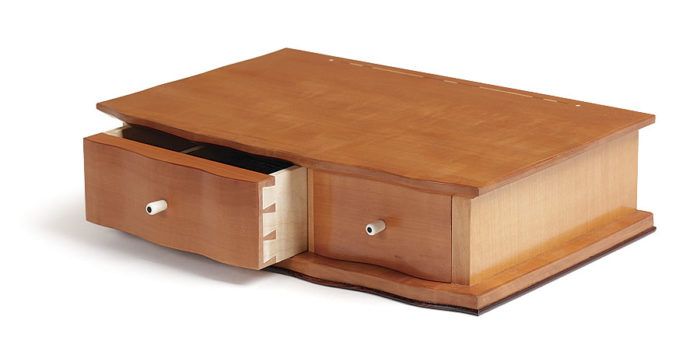5 Takes on the Tea Box
We asked a few of our best makers to design and build a box to hold tea. Check out what they made.

The idea was simple: Ask a few Fine Woodworking contributing editors to make a box to hold tea bags. We gave them dimensions for the bags, but no other design constraints. Then we waited for the boxes to get made and sent to us. As we expected, Christian Becksvoort, Michael Fortune, Garrett Hack, Roland Johnson, and Steve Latta created boxes that are beautiful, elegant, practical, and charming. However, we were a bit surprised by just how well each box expressed the personality of its creator. There’s just no mistaking who made which box.
The power of waves
My tea box evolved from my fascination with the patterns formed by waves and running water. Construction is simple and elegant—sliding dovetails join the sides to the top and bottom—and creates overhangs that I shaped into asymmetric curves based on the irregularity and randomness of waves. The drawer fronts are wavy, too. I find slight differences in the alignment of the waves across the front more alluring than perfect consistency between top, drawers, and bottom. The figure of the curly pear I used for the case and drawer fronts enhances this wave energy, and the rosewood bead below the bottom reinforces the shape.
—Garrett Hack

A handy tea tote
When I first considered the tea caddy, I envisioned one with a shape that matched the simplicity of its purpose. I also wanted the caddy to express my sense of humor, which is unusual according to many of my friends. The idea of using a handplane came about while I was discussing Bailey transitional planes with another woodworker, who remarked that they make better decorations than tools. Thinking about this, I had an epiphany in my shop, realizing that a jack plane blade is the exact width of many tea bags. After removing the blade assembly, the frog, and a bit of cast iron, there was just enough room for an assortment of tea bags. I had my plain (or plane) tea caddy. I added a bit of material on each end of the plane body for jars that could hold sugar.
—Roland Johnson
 From Fine Woodworking #257
From Fine Woodworking #257
For the full article, download the PDF below:
Fine Woodworking Recommended Products

Circle Guide

Compass

Blackwing Pencils






Comments
I really liked Christian Becksvoort "light refreshing..." tea box and tried making it. It's not as easy as it looks. What I'm really wondering is what Mr. Becksvoort glue up strategy was? Typical large clamps don't work well. Did he use straps or heavy rubber bands around a form? Lots of pieces there to glue up accurately. I'd really like to know what his strategy was.
Hans
I love the work of Garrett Hack. I am going to build something like his with lacewood for my son. OMG is that stuff hard and dense. And just for fun I am going to put a drawer on the side for no particular purpose! I am not sure how or what to use for inlay. The lacewood has an amazing grain pattern. Perhaps an ebony and holly strip in morse code like Garrett has done in the past. What a great idea for the magazine.
Would love for more articles like this. I know it's probably a bear to produce but its so interesting to see the different approaches by the different makers with the same prompt.
This is one of my favorite articles. It's great to compare each builders style when given the same task.
Log in or create an account to post a comment.
Sign up Log in